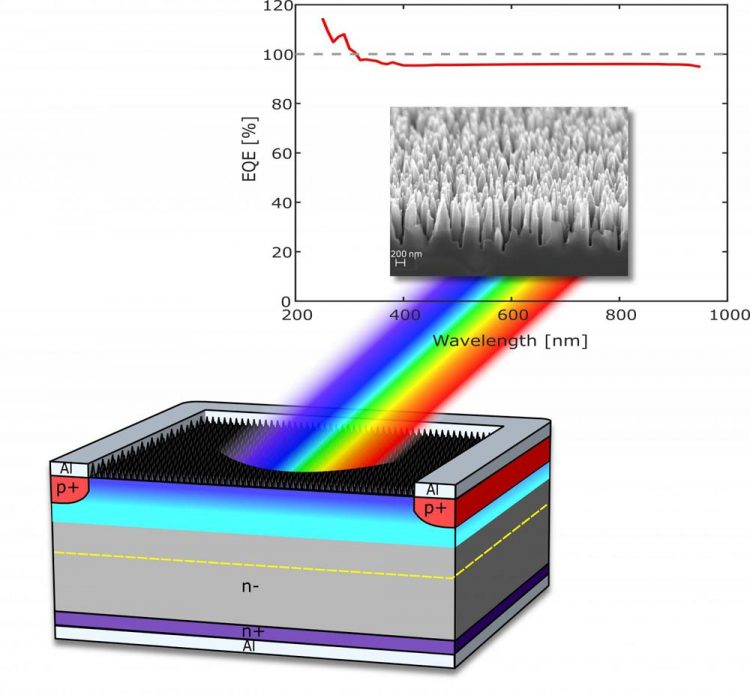Light detector with record-high sensitivity to revolutionize imaging

Structure and performance of the novel photodetector. Credit: Aalto University
The research team led by Professor Hele Savin has developed a new light detector that can capture more than 96 percent of the photons covering visible, ultraviolet and infrared wavelengths.
“Present-day light detectors suffer from severe reflection losses as currently used antireflection coatings are limited to specific wavelengths and a fixed angle of incidence. Our detector captures light without such limitations by taking advantage of a nanostructured surface. Low incident angle is useful especially in scintillating x-ray sensors”, Savin explains.
“We also addressed electrical losses present in traditional sensors that utilize semiconductor pn-junctions for light collection. Our detector does not need any dopants to collect light – instead we use an inversion layer generated by atomic layer deposited thin film.”
The new concept for light detection kindled from the team's earlier research on nanostructured solar cells. Indeed, the nanostructure used in the light detector is similar to that used by the team a couple of years ago in their record-high efficiency black silicon solar cells.
The team has filed a patent application for the new light detector. The prototype detectors are currently being tested in imaging applications related to medicine and safety. The team is also continuously seeking new applications for their invention, especially among the ultraviolet and infrared ranges that would benefit from the superior spectral response.
The research results were published 14.11.2016 in Nature Photonics scientific journal. Link to the article http://dx.
###
More information
Professor Hele Savin
Tel. +358 50 541 0156
hele.savin@aalto.fi
Researcher Mikko Juntunen
mikko.juntunen@aalto.fi
Media Contact
All latest news from the category: Physics and Astronomy
This area deals with the fundamental laws and building blocks of nature and how they interact, the properties and the behavior of matter, and research into space and time and their structures.
innovations-report provides in-depth reports and articles on subjects such as astrophysics, laser technologies, nuclear, quantum, particle and solid-state physics, nanotechnologies, planetary research and findings (Mars, Venus) and developments related to the Hubble Telescope.
Newest articles

A universal framework for spatial biology
SpatialData is a freely accessible tool to unify and integrate data from different omics technologies accounting for spatial information, which can provide holistic insights into health and disease. Biological processes…

How complex biological processes arise
A $20 million grant from the U.S. National Science Foundation (NSF) will support the establishment and operation of the National Synthesis Center for Emergence in the Molecular and Cellular Sciences (NCEMS) at…

Airborne single-photon lidar system achieves high-resolution 3D imaging
Compact, low-power system opens doors for photon-efficient drone and satellite-based environmental monitoring and mapping. Researchers have developed a compact and lightweight single-photon airborne lidar system that can acquire high-resolution 3D…





















